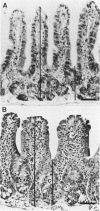Abstract
Cryptosporidia from natural cryptosporidiosis in guinea pigs were experimentally transmitted to both adult and juvenile guinea pigs. Cryptosporidia were associated with the villi of the ileum, jejunum, and duodenum. Both juveniles and adults were equally susceptible to cryptosporidia, as determined by decreases in villus height, increases in crypt depth, and decreases in villus height/crypt depth ratios, when compared with uninoculated animals. When multiple paired comparisons were made between 2 and 10 days postinoculation, there were significant decreases in villus height/crypt depth ratios with time. A dose study showed that 6-week-old guinea pigs were all infected with doses as low as 325 oocysts per animal. When sampled at weekly intervals postinoculation, guinea pigs had significant evidence of infection up to 2 weeks but had recovered completely by 4 weeks. Guinea pigs mounted a specific humoral immune response against cryptosporidia, as measured by an immunoperoxidase technique. Guinea pigs challenged by reinoculation with cryptosporidial oocysts were completely refractory to reinfection. These studies show that cryptosporidiosis in guinea pigs is a useful small animal model of this disease.
Full text
PDF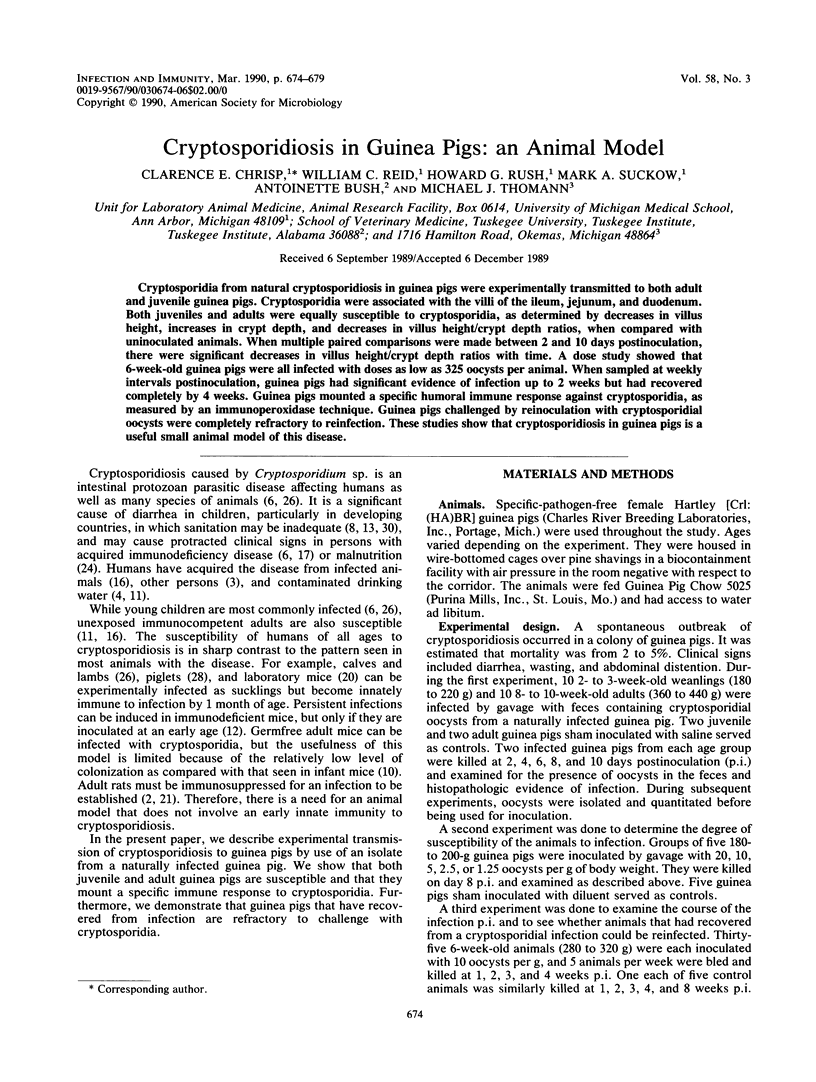
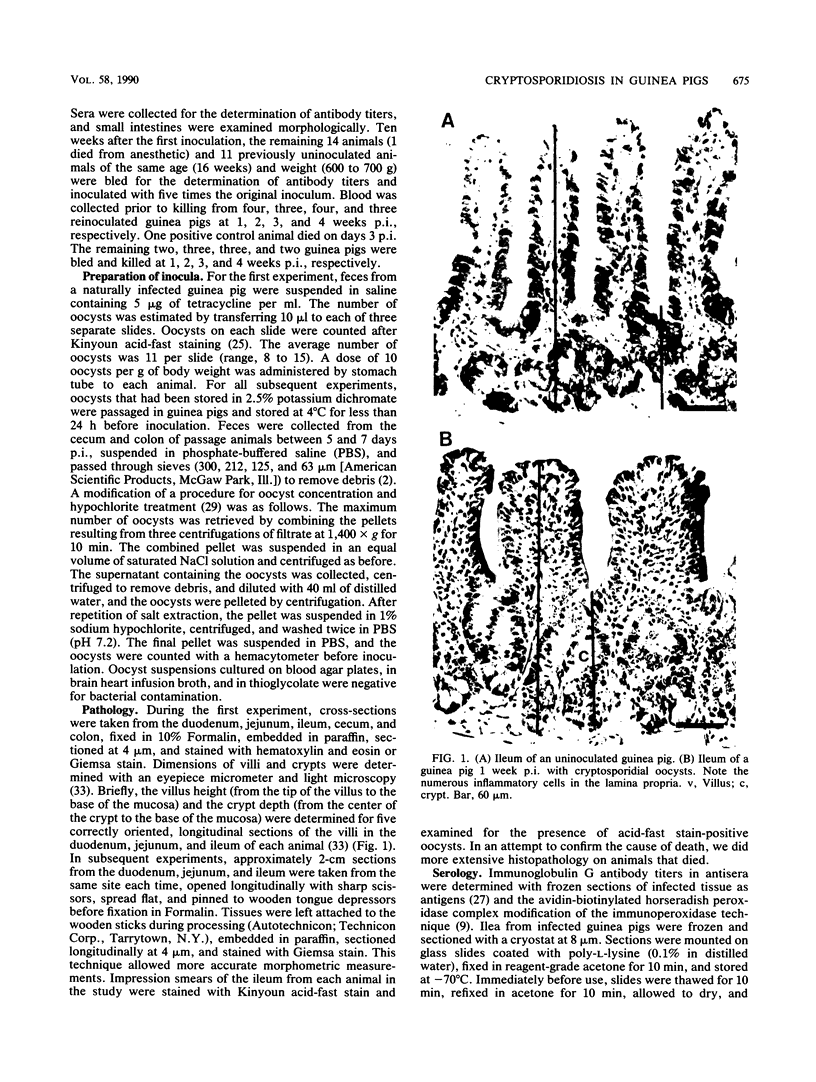
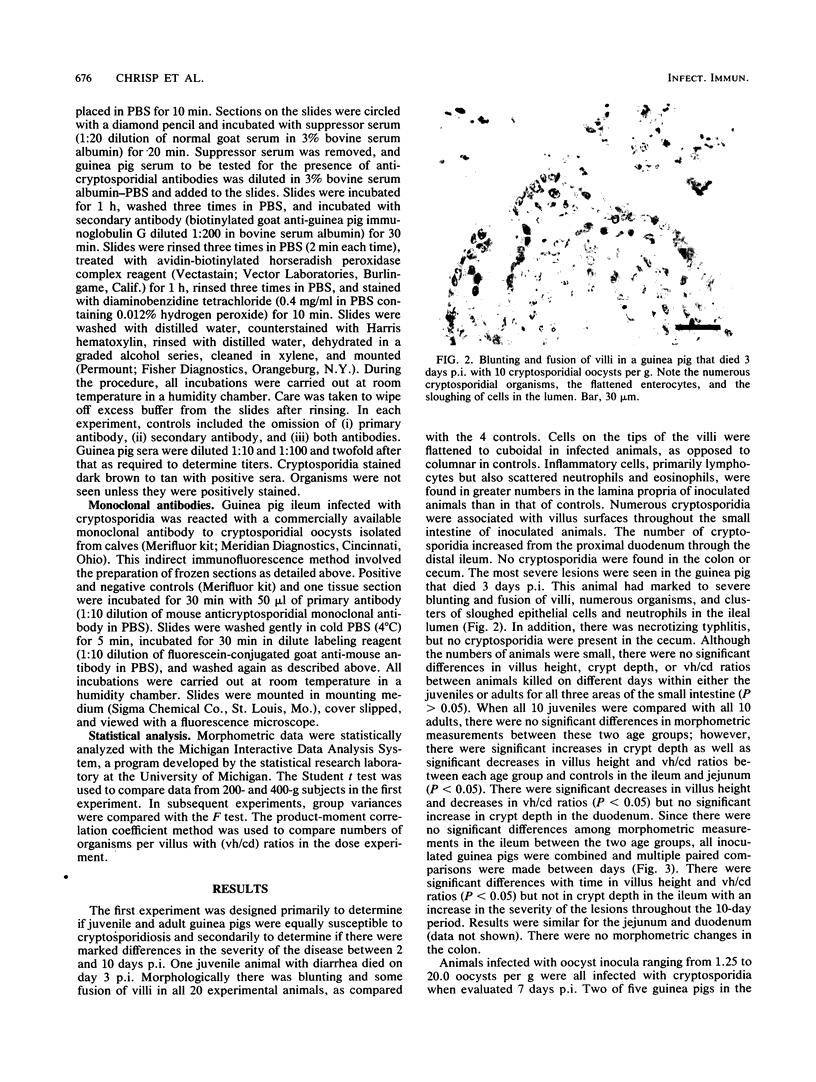
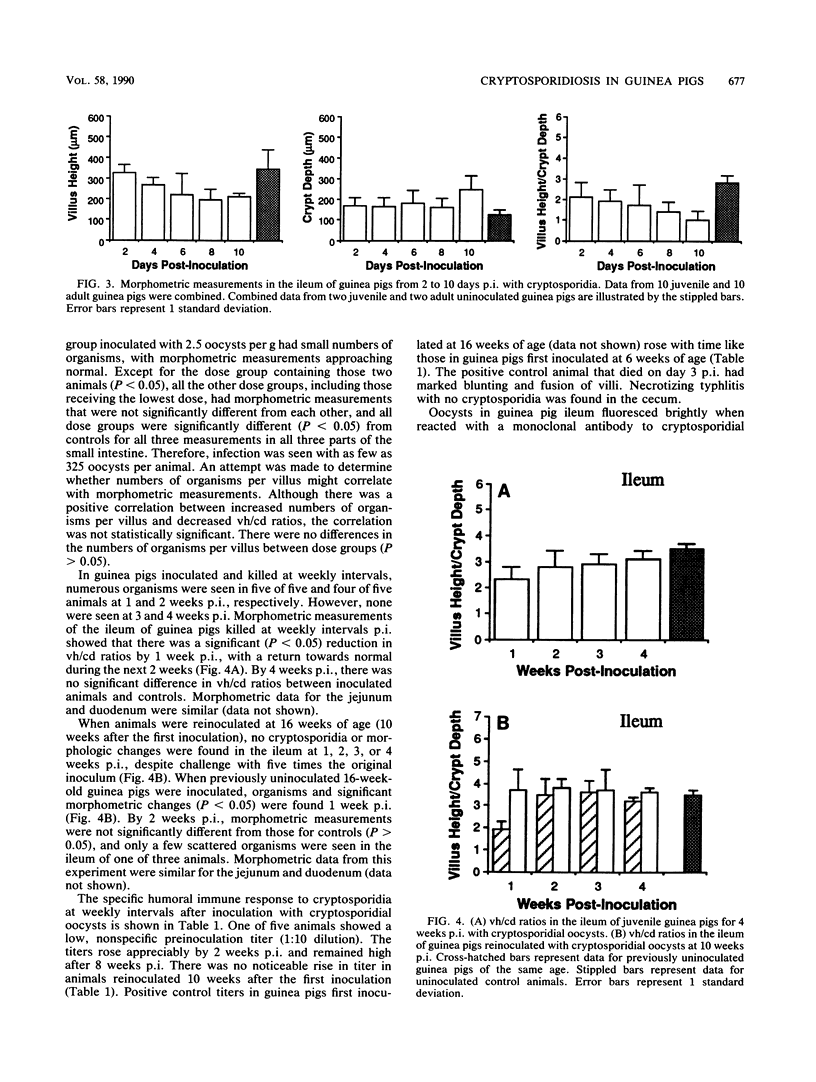
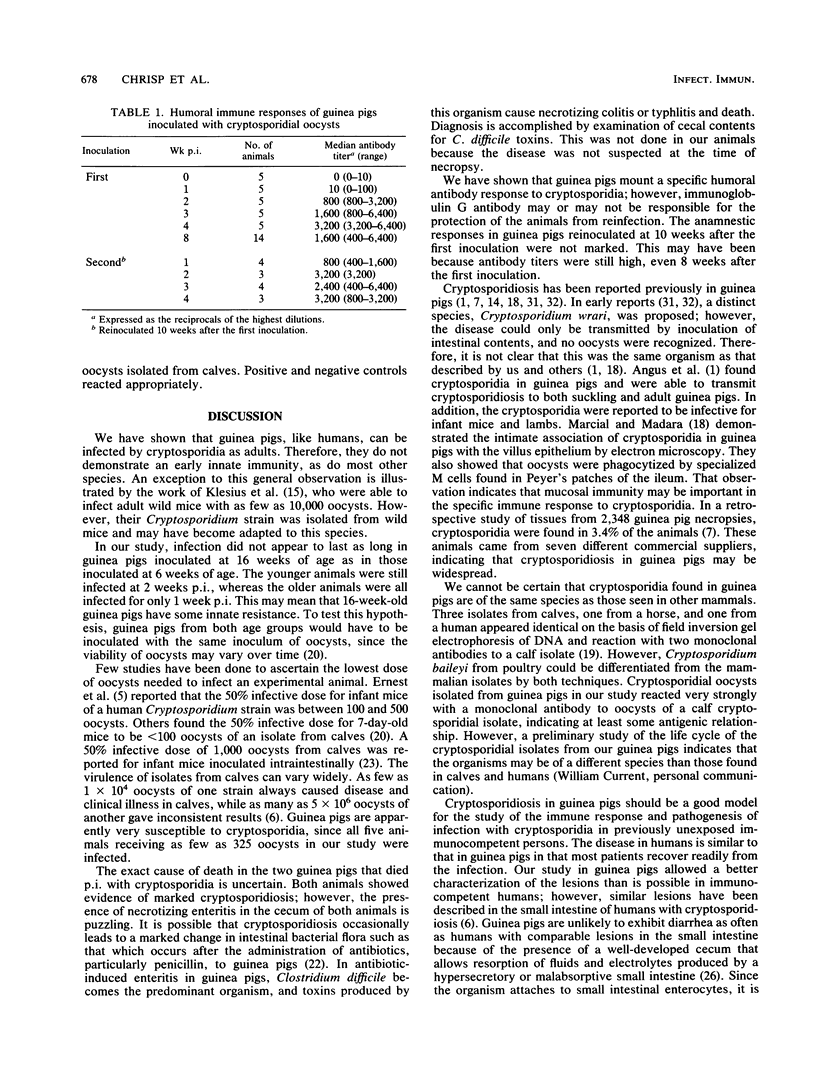
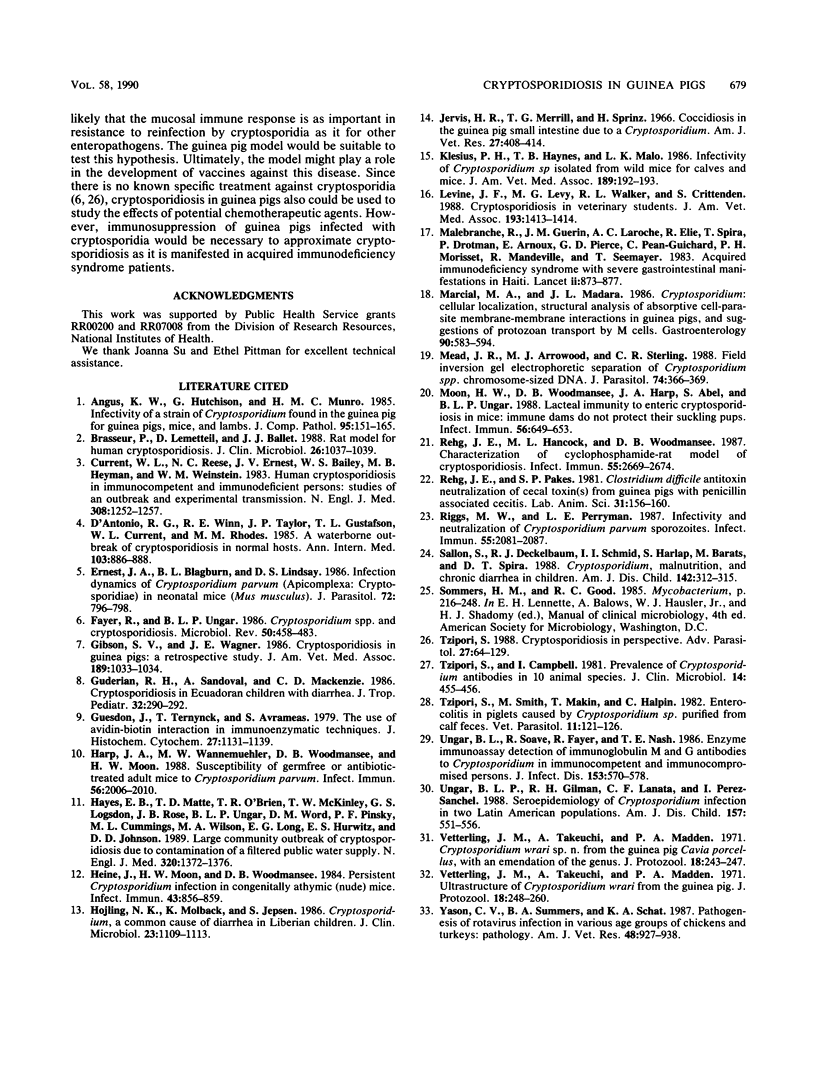
Images in this article
Selected References
These references are in PubMed. This may not be the complete list of references from this article.
- Angus K. W., Hutchison G., Munro H. M. Infectivity of a strain of Cryptosporidium found in the guinea-pig (Cavia porcellus) for guinea-pigs, mice and lambs. J Comp Pathol. 1985 Apr;95(2):151–165. doi: 10.1016/0021-9975(85)90002-7. [DOI] [PubMed] [Google Scholar]
- Brasseur P., Lemeteil D., Ballet J. J. Rat model for human cryptosporidiosis. J Clin Microbiol. 1988 May;26(5):1037–1039. doi: 10.1128/jcm.26.5.1037-1039.1988. [DOI] [PMC free article] [PubMed] [Google Scholar]
- Current W. L., Reese N. C., Ernst J. V., Bailey W. S., Heyman M. B., Weinstein W. M. Human cryptosporidiosis in immunocompetent and immunodeficient persons. Studies of an outbreak and experimental transmission. N Engl J Med. 1983 May 26;308(21):1252–1257. doi: 10.1056/NEJM198305263082102. [DOI] [PubMed] [Google Scholar]
- D'Antonio R. G., Winn R. E., Taylor J. P., Gustafson T. L., Current W. L., Rhodes M. M., Gary G. W., Jr, Zajac R. A. A waterborne outbreak of cryptosporidiosis in normal hosts. Ann Intern Med. 1985 Dec;103(6 ):886–888. doi: 10.7326/0003-4819-103-6-886. [DOI] [PubMed] [Google Scholar]
- Ernest J. A., Blagburn B. L., Lindsay D. S., Current W. L. Infection dynamics of Cryptosporidium parvum (Apicomplexa: Cryptosporiidae) in neonatal mice (Mus musculus). J Parasitol. 1986 Oct;72(5):796–798. [PubMed] [Google Scholar]
- Fayer R., Ungar B. L. Cryptosporidium spp. and cryptosporidiosis. Microbiol Rev. 1986 Dec;50(4):458–483. doi: 10.1128/mr.50.4.458-483.1986. [DOI] [PMC free article] [PubMed] [Google Scholar]
- Gibson S. V., Wagner J. E. Cryptosporidiosis in guinea pigs: a retrospective study. J Am Vet Med Assoc. 1986 Nov 1;189(9):1033–1034. [PubMed] [Google Scholar]
- Guderian R. H., Sandoval C. A., Mackenzie C. D. Cryptosporidiosis in Ecuadorian children with acute diarrhoea. J Trop Pediatr. 1986 Dec;32(6):290–292. doi: 10.1093/tropej/32.6.290. [DOI] [PubMed] [Google Scholar]
- Guesdon J. L., Ternynck T., Avrameas S. The use of avidin-biotin interaction in immunoenzymatic techniques. J Histochem Cytochem. 1979 Aug;27(8):1131–1139. doi: 10.1177/27.8.90074. [DOI] [PubMed] [Google Scholar]
- Harp J. A., Wannemuehler M. W., Woodmansee D. B., Moon H. W. Susceptibility of germfree or antibiotic-treated adult mice to Cryptosporidium parvum. Infect Immun. 1988 Aug;56(8):2006–2010. doi: 10.1128/iai.56.8.2006-2010.1988. [DOI] [PMC free article] [PubMed] [Google Scholar]
- Hayes E. B., Matte T. D., O'Brien T. R., McKinley T. W., Logsdon G. S., Rose J. B., Ungar B. L., Word D. M., Pinsky P. F., Cummings M. L. Large community outbreak of cryptosporidiosis due to contamination of a filtered public water supply. N Engl J Med. 1989 May 25;320(21):1372–1376. doi: 10.1056/NEJM198905253202103. [DOI] [PubMed] [Google Scholar]
- Heine J., Moon H. W., Woodmansee D. B. Persistent Cryptosporidium infection in congenitally athymic (nude) mice. Infect Immun. 1984 Mar;43(3):856–859. doi: 10.1128/iai.43.3.856-859.1984. [DOI] [PMC free article] [PubMed] [Google Scholar]
- Højlyng N., Mølbak K., Jepsen S. Cryptosporidium spp., a frequent cause of diarrhea in Liberian children. J Clin Microbiol. 1986 Jun;23(6):1109–1113. doi: 10.1128/jcm.23.6.1109-1113.1986. [DOI] [PMC free article] [PubMed] [Google Scholar]
- Jervis H. R., Merrill T. G., Sprinz H. Coccidiosis in the guinea pig small intestine due to a Cryptosporidium. Am J Vet Res. 1966 Mar;27(117):408–414. [PubMed] [Google Scholar]
- Klesius P. H., Haynes T. B., Malo L. K. Infectivity of Cryptosporidium sp isolated from wild mice for calves and mice. J Am Vet Med Assoc. 1986 Jul 15;189(2):192–193. [PubMed] [Google Scholar]
- Levine J. F., Levy M. G., Walker R. L., Crittenden S. Cryptosporidiosis in veterinary students. J Am Vet Med Assoc. 1988 Dec 1;193(11):1413–1414. [PubMed] [Google Scholar]
- Malebranche R., Arnoux E., Guérin J. M., Pierre G. D., Laroche A. C., Péan-Guichard C., Elie R., Morisset P. H., Spira T., Mandeville R. Acquired immunodeficiency syndrome with severe gastrointestinal manifestations in Haiti. Lancet. 1983 Oct 15;2(8355):873–878. doi: 10.1016/s0140-6736(83)90868-1. [DOI] [PubMed] [Google Scholar]
- Marcial M. A., Madara J. L. Cryptosporidium: cellular localization, structural analysis of absorptive cell-parasite membrane-membrane interactions in guinea pigs, and suggestion of protozoan transport by M cells. Gastroenterology. 1986 Mar;90(3):583–594. doi: 10.1016/0016-5085(86)91112-1. [DOI] [PubMed] [Google Scholar]
- Mead J. R., Arrowood M. J., Current W. L., Sterling C. R. Field inversion gel electrophoretic separation of Cryptosporidium spp. chromosome-sized DNA. J Parasitol. 1988 Jun;74(3):366–369. [PubMed] [Google Scholar]
- Moon H. W., Woodmansee D. B., Harp J. A., Abel S., Ungar B. L. Lacteal immunity to enteric cryptosporidiosis in mice: immune dams do not protect their suckling pups. Infect Immun. 1988 Mar;56(3):649–653. doi: 10.1128/iai.56.3.649-653.1988. [DOI] [PMC free article] [PubMed] [Google Scholar]
- Rehg J. E., Hancock M. L., Woodmansee D. B. Characterization of cyclophosphamide-rat model of cryptosporidiosis. Infect Immun. 1987 Nov;55(11):2669–2674. doi: 10.1128/iai.55.11.2669-2674.1987. [DOI] [PMC free article] [PubMed] [Google Scholar]
- Rehg J. E., Pakes S. P. Clostridium difficile antitoxin neutralization of cecal toxin(s) from guinea pigs with penicillin-associated colitis. Lab Anim Sci. 1981 Apr;31(2):156–160. [PubMed] [Google Scholar]
- Riggs M. W., Perryman L. E. Infectivity and neutralization of Cryptosporidium parvum sporozoites. Infect Immun. 1987 Sep;55(9):2081–2087. doi: 10.1128/iai.55.9.2081-2087.1987. [DOI] [PMC free article] [PubMed] [Google Scholar]
- Sallon S., Deckelbaum R. J., Schmid I. I., Harlap S., Baras M., Spira D. T. Cryptosporidium, malnutrition, and chronic diarrhea in children. Am J Dis Child. 1988 Mar;142(3):312–315. doi: 10.1001/archpedi.1988.02150030086027. [DOI] [PubMed] [Google Scholar]
- Tzipori S., Campbell I. Prevalence of Cryptosporidium antibodies in 10 animal species. J Clin Microbiol. 1981 Oct;14(4):455–456. doi: 10.1128/jcm.14.4.455-456.1981. [DOI] [PMC free article] [PubMed] [Google Scholar]
- Tzipori S. Cryptosporidiosis in perspective. Adv Parasitol. 1988;27:63–129. doi: 10.1016/S0065-308X(08)60353-X. [DOI] [PMC free article] [PubMed] [Google Scholar]
- Tzipori S., Smith M., Makin T., Halpin C. Enterocolitis in piglets caused by Cryptosporidium sp. purified from calf faeces. Vet Parasitol. 1982 Nov;11(2-3):121–126. doi: 10.1016/0304-4017(82)90033-4. [DOI] [PubMed] [Google Scholar]
- Ungar B. L., Gilman R. H., Lanata C. F., Perez-Schael I. Seroepidemiology of Cryptosporidium infection in two Latin American populations. J Infect Dis. 1988 Mar;157(3):551–556. doi: 10.1093/infdis/157.3.551. [DOI] [PubMed] [Google Scholar]
- Ungar B. L., Soave R., Fayer R., Nash T. E. Enzyme immunoassay detection of immunoglobulin M and G antibodies to Cryptosporidium in immunocompetent and immunocompromised persons. J Infect Dis. 1986 Mar;153(3):570–578. doi: 10.1093/infdis/153.3.570. [DOI] [PubMed] [Google Scholar]
- Vetterling J. M., Jervis H. R., Merrill T. G., Sprinz H. Cryptosporidium wrairi sp. n. from the guinea pig Cavia porcellus, with an emendation of the genus. J Protozool. 1971 May;18(2):243–247. doi: 10.1111/j.1550-7408.1971.tb03315.x. [DOI] [PubMed] [Google Scholar]
- Vetterling J. M., Takeuchi A., Madden P. A. Ultrastructure of Cryptosporidium wrairi from the guinea pig. J Protozool. 1971 May;18(2):248–260. doi: 10.1111/j.1550-7408.1971.tb03316.x. [DOI] [PubMed] [Google Scholar]
- Yason C. V., Summers B. A., Schat K. A. Pathogenesis of rotavirus infection in various age groups of chickens and turkeys: pathology. Am J Vet Res. 1987 Jun;48(6):927–938. [PubMed] [Google Scholar]



